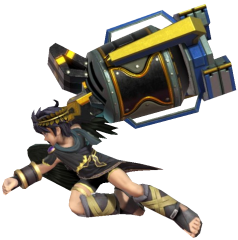So before I get into the meat of this, I want to mention that everything you're going to see in this post is not accurate 100%. The things covered do
not account for all variables.
Everything here are
approximations and should be
treated as such. While we can look at some variables,
we can't track them all due to the unpredictability of life. So keep that in mind when reading this.
And even if the process I'm about to mention is arguably hysterical and overzealous for a game like Smash, I did have a lot of fun doing this. So I thought I would share on how it was done and what we can take away from this.
To start... some background. Of course, the Fighters Pass is almost complete, with one fighter left to be revealed. And, due to that, a lot are wondering about the release date of that character.
Well... after thinking about it for awhile, and thinking about tools I could potentially use to help get
some sort of info without rumors, I turned to the one that's been pretty accurate so far. And that's
Amiibo Theory.
In short, the theory explains that the amiibo release dates are tied with fighter releases as they release close to each other. And ever since Piranha Plant's release, it's had a decent track record.
So I decided to test the limits of the theory using...
mathematics.
What I decided to do was record the
release dates for all DLC fighters and Amiibo releases as a basis (of course.) However, I decided, instead of just focusing on North America, I also collected data from
Europe and Japan as well. As, unsurprisingly, there are
variations in the dates.
So after that was recorded, I had to arguably do the hardest part,
make the dates universal under one scale. For convenience, I used January 1st, 2019 as
one while December 31st, 2018 was
zero. And from there, everything was basically
in the terms of January of 2019.
As an example if I needed to record February 3rd, 2019; I'd record it as January
34th, 2019 instead. I know that sounds weird, but it got those dates in a uniform scale.
So once I converted all those dates, I plotted the data using
Desmos, a widely popular online graphing tool. For the input data (x), I used the converted amiibo dates, and for the output (y) was the converted dlc release dates.
From there, I used the technique known as
linear regression, which finds the math function that closely suites the data. And that function was just a simple y=mx+b equation.
Well, using that amiibo date for
Dark Samus and Richter (January 17th), I plugged into the function.
Well...
four functions actually. Yeah, I said there was variations in the data. And because of that, I regressed equations for each of the data sets. Even though there were three regions, I ended up with
four because the 4th one was
all the data sets averaged together.
So after I plugged the date into all four functions, what did I get? Well, I ended with these dates for each data set. (linked are graphs to each of the functions for those interested.)
It seems like Amiibo Theory is trending towards an early-ish January release. Which, reasonably, would make sense as a Direct is speculated for this time. And you could have a shadow drop of sorts, maybe.
Well, after all of this, I kind of got in the mood for more statistical stuff. So I decided to compare release dates with
reveal dates (instead of the Amiibo dates like done previously.)
Now, I do want to mention that the comparison of reveal dates with release dates is
not as strong of a foundation as the amiibo comparison is. This means, in terms of the data, they're a bit more scattered than close together.
Still, I went on to regress the data into a linear function. I also looked at data for North America, Europe, and Japan. Along with taking the average of all of them.
Even though this data has less structure... it's still
really interesting. All of the dates *
were basically similar to each other in being a conservative date (near the February 2020 deadline basically.)
Now, at this point, I collected most of the data that could be used. However, I had one more trick up my sleeve. I decided to also
average each comparison's output together. (Basically just average the dates I got from the amiibo/release comparison with the ones I got from the reveal/release comparison.)
And here's the dates I got (no graphs for this one sadly):
- North America: January 31st
- Europe: February 1st
- Japan: February 3rd
- Average: February 1st
So basically, there was a lot of math involved in this. It sounds so dumb to do this much, but I honestly had blast going through all of that data.
But again, it is important to recognize that these dates are
approximations and in retrospect
probably don't mean much. But it at least is something to keep an eye on as Nintendo is ready to move into the rest of the year.
If anyone is interested in the data itself, let me know and I can release it in a doc as soon as possible.





